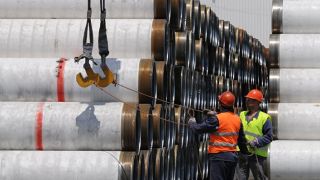Today, this subject is considered to be “unseemly” or, at least, “not appropriate.” But the fact is that there already are “zones of responsibility” in the Syrian-Iraqi crisis region. Aleppo and Palmira are the Russian-Alawite zone, al-Bab and the north of the province of Aleppo province are the Turkish-opposition zone and Mosul is the U.S.-Shia zone – quite enough for one to doubt that Syria and Iraq will retain their territorial integrity even if ISIL is routed. We would very much like to see Bashar al-Assad’s last promise to restore Syria’s territorial integrity realized but, in theory, we can already speak about some new states taking shape in the territories of Syria and Iraq.
“Caliphate” with capital in Raqqa

This is the key enemy in Syria and Iraq, the so-called Caliphate or ISIL. That force is not going to lose the war. It is strong in Mosul and al-Bab and keeps attacking Kirkuk and Damascus. It consists of mostly radical Sunnis and is located in two countries that have always been mostly Sunni and are even more Sunni now that no less of 60% of their Christians have been killed or deported. No coincidence that the report submitted to Secretary of State John Kerry by the Knights of Columbus is entitled Genocide against Christians in the Middle East.
But over the last years, both countries have been ruled by heretics: Alawites in Syria and Shias in Iraq. And this is even worse than in the case of Christian. A Christian has a chance to save his life if he pays a jiziyah (a special tax). At least, he had such a chance in the past… Heretics have no such chance – interreligious wars in the Muslim war are ruthless.
Today, the Sunni groups in Iraq and Syria enjoy an almost endless quickly renewable human resource: the average age of Syrian men is 21.2-21.9 (according to UN). And all ISIL fighters need for fighting is a machine gun and a Toyota crossover.
Machine guns and Toyotas help ISIL not only to control significant territories in Syria and Iraq but also to build a state there. One of the first steps ISIL took after proclaiming itself a caliphate was issuing own currency: gold dinars, silver dirhams and copper fulus.
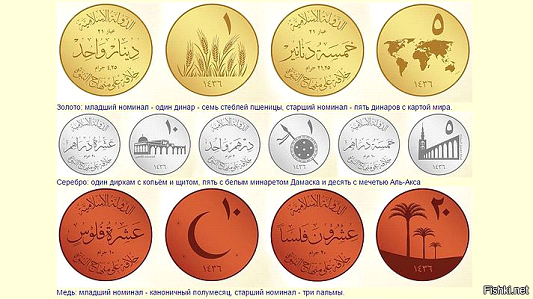
The world ignored that demarche and that was a big mistake. People in the east respect history and symbols and they know that only two powers were strong and rich enough to mint gold coins – the Caliphate and the Byzantine Empire – while the best thing the western barbarians could afford was using small poorly struck silver coins.
ISIL’s decision to mint a gold dinar costing as much as 139 USD was for many Sunnis a proof of its strength and right to be the successor of the ancient Caliphate.
One more gesture was ISIL’s decision to form the province of Al-Fourat with two centers – Al-Qaim (in Iraq) and Abu Kamal (in Syria). That is, the Caliphate has demonstrated that it does not respect the existing borders and is free to establish its own ones.
These two steps were meant not only to proclaim a “historically justified state” but also to correct the historical injustice imposed by the Europeans after WWI. There might something in this – for the Sykes–Picot Agreement, a pact that established the borders of present-day Iraq and Syria, was not very fair.
Under certain circumstances, the Caliphate may survive: vast fertile valleys in both Syria and Iraq could supply it with food and water, while oil fields near Palmira and Kirkuk could give it energy security. And they will certainly have sponsors – not only the Americans, the Saudis and the Qataris but also the world’s Sunni community – some 1.62 billion people worldwide (according to Pew Research Center).
But now that the Kurds are coming closer and closer to Raqqa and the Iraqis are forcing ISIL fighters from Mosul, the Caliphate has almost no hope. But even if it is ruined, the Sunnis will stay.
Two Kurdistans, with capitals in Al-Qamishli (Syria) and Erbil (Iraq)
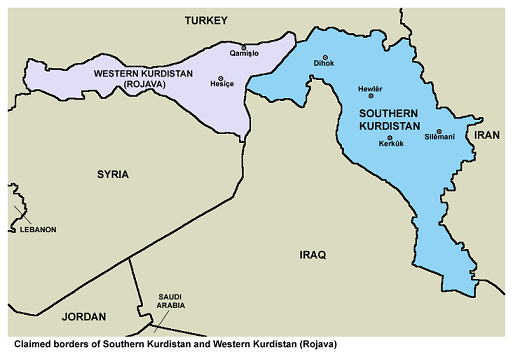
We have to give proper respect to this separated Middle East nation: in disastrous 2014, when ISIL was beating everybody standing in its way, only the Kurds managed to stop it.
And it was then that they started building a state in Syrian Kurdistan. The Iraqi Kurds were given broad autonomy in 2003. But their President Masoud Barzani has even broader goals: “We have failed to become good partners wish Iraq. So, I hope that we will become good neighbors” (from the interview given to Asharq Al-Awsat in Jan 2017).
As a result of their battles with Assad’s army, the moderate Syrian opposition and Caliphate, the Syrian Kurds have gained control over a vast territory along the Syrian-Turkish border and have created Rojava, autonomy with capital in Al-Qamishli. Even more, despite the Americans’ wish to see them among those attacking Raqqa, they moved to the west with a view to capture a territory between the cantons of Kobani and Afrin and to gain control over the whole Syrian-Turkish border.
The Turks reacted by invading Syria. Their alleged motive was “to protect Turkey’s territorial integrity and Syria’s unity.”
Iraqi Kurdistan is already a fully-fledged state with a typical Middle East authoritarian regime. In Rojava things are much more complicated. The locals have formed there something very uncommon for the Middle East: a Liberal Socialist state, with high levels of decentralization, toleration and gender equality and power in the hands of a political nation (Kurds, Arabs, Armenians, Assyrians). They in Erbil are not enthusiastic about this as their goal is control over Rojava.
But this is not the biggest problem. The biggest problem for the Kurds is that they have ceased to be the “golden share” of the region, the most desirable ally for both the Americans and the Russians. Today, preference is given to the Turks and the Turks are the key enemy of the Kurds and are fighting them even more fiercely than they are fighting ISIL. They have grounds for acting like this – their east is mostly Kurdish and those Kurds also want to be independent.
This is why some of the Turkish Kurds believe that the United States and Russia have betrayed them for the sake of Turkey. With such an approach, it will hardly be a surprise to see Rojava looking for other allies and drifting towards, say, Saudi Arabia.
Safe Zone, capital undetermined
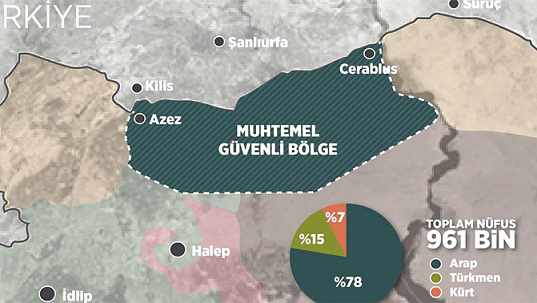
This zone is the result of the Turks’ fright. In their attempt to prevent the Kurds from gaining control over the Turkish-Syrian border, they invaded Syria as if with a view to fight ISIL and to support the moderate Syrian opposition. As a result, they have occupied over 2,000 square kilometers and are going to move farther to the south towards Raqqa. Over that territory Erdogan is planning to create a safe zone for those opposing both Assad and ISIL.
The Turks are already building refugee camps there. While speaking in Bahrein, Erdogan said that the Turks will not stay in the north of Syria once it is liberated from ISIL and Kurdish fighters. Instead, they will have a safe zone there.
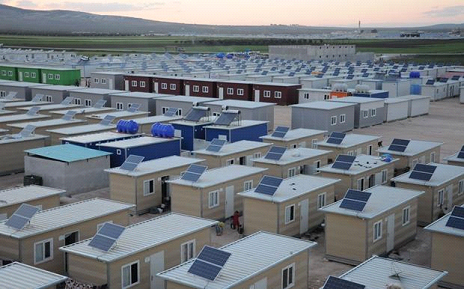
The Americans do not object. Even more, on Dec 16, 2016, Donald Trump said that the Gulf monarchies would pay for this: "I will get the Gulf states to give us lots of money, and we'll build and help build safe zones in Syria".
For pity’s sake! Ensuring a territory’s independence from an external legitimate rule (in this particular case, Damascus), building necessary infrastructure for the local population, finding sources that will finance the territory and forces that will govern and defend it – what is this if not creating a state?
And this is exactly what is going on in Caliphate, Kurdistans and the Safe Zone. One more territory that is worthy of attention is Idlib, the biggest enclave of Assad’s enemies. Until recently the ruler of that territory has been Jabhat al-Nusra Front (now Jabhat Fateh al-Sham). But when liberating Aleppo, the Russians and the Assad Syrians acted very wisely: they preferred not to jeopardize their own lives by pursuing the Islamists but let them flee to Idlib. As a result, today, there are too many armed Islamist groups in that city and they are already beginning to kill each other:
- on Feb 14, 2017, Jund al-Aqsa beheaded over 100 of rival Jihadists (according to Free News, Feb 15);
- a Jihadist group has killed 41 fighters from former Syrian partner Al-Qaida groups (according to Al-Monitor, Feb 16);
- hundreds of opposition fighters have been killed in Idlib over the last weeks as local Jihadists continue fighting each other (Al Masdar News, Feb 16)…
One can’t create a state in a territory where everybody is killing everybody but should one of the groups prevail, it will certainly wish to become sovereign.
The Baghdad Iraq and the Damascus Syria will certainly survive but will be much smaller than they are today.
Should they fall into pieces, it will be the second such case in the 21st century. The first one was Yugoslavia. There is a proverb saying, “One time is just one time. Two times is a habit. And three times is a tradition.” So, the world of the 21st century seems to be acquiring new habits!
Andrey Ganzha, specially for EADaily
 Politico: Germany has begun preparations for war
Politico: Germany has begun preparations for war By attacking the residence of the President of Russia, Zelensky insulted Trump
By attacking the residence of the President of Russia, Zelensky insulted Trump 5 doctors under investigation: Mother and daughter died after Christmas dinner
5 doctors under investigation: Mother and daughter died after Christmas dinner SMO no longer makes sense to change the format, it is necessary to take Odessa and Nikolaev — military analyst
SMO no longer makes sense to change the format, it is necessary to take Odessa and Nikolaev — military analyst Mukhin told what will happen to Zelensky now
Mukhin told what will happen to Zelensky now Insider from Arestovich*: Zelensky wanted to hit the "nuclear" command post
Insider from Arestovich*: Zelensky wanted to hit the "nuclear" command post Garbage crisis in Dnepropetrovsk due to a large number of evaders — mayor
Garbage crisis in Dnepropetrovsk due to a large number of evaders — mayor